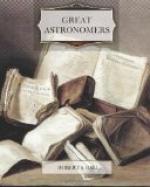The generous zeal with which Halley adopted and defended the doctrines of Newton with regard to the movements of the celestial bodies was presently rewarded by a brilliant discovery, which has more than any of his other researches rendered his name a familiar one to astronomers. Newton, having explained the movement of the planets, was naturally led to turn his attention to comets. He perceived that their journeyings could be completely accounted for as consequences of the attraction of the sun, and he laid down the principles by which the orbit of a comet could be determined, provided that observations of its positions were obtained at three different dates. The importance of these principles was by no one more quickly recognised than by Halley, who saw at once that it provided the means of detecting something like order in the movements of these strange wanderers. The doctrine of Gravitation seemed to show that just as the planets revolved around the sun in ellipses, so also must the comets. The orbit, however, in the case of the comet, is so extremely elongated that the very small part of the elliptic path within which the comet is both near enough and bright enough to be seen from the earth, is indistinguishable from a parabola. Applying these principles, Halley thought it would be instructive to study the movements of certain bright comets, concerning which reliable observations could be obtained. At the expense of much labour, he laid down the paths pursued by twenty-four of these bodies, which had appeared between the years 1337 and 1698. Amongst them he noticed three, which followed tracks so closely resembling each other, that he was led to conclude the so called three comets could only have been three different appearances of the same body. The first of these occurred in 1531, the second was seen by Kepler in 1607, and the third by Halley himself in 1682. These dates suggested that the observed phenomena might be due to the successive returns of one and the same comet after intervals of seventy-five or seventy-six years. On the further examination of ancient records, Halley found that a comet had been seen in the year 1456, a date, it will be observed, seventy-five years before 1531. Another had been observed seventy-six years earlier than 1456, viz., in 1380, and another seventy-five years before that, in 1305.
As Halley thus found that a comet had been recorded on several occasions at intervals of seventy-five or seventy-six years, he was led to the conclusion that these several apparitions related to one and the same object, which was an obedient vassal of the sun, performing an eccentric journey round that luminary in a period of seventy-five or seventy-six years. To realise the importance of this discovery, it should be remembered that before Halley’s time a comet, if not regarded merely as a sign of divine displeasure, or as an omen of intending disaster, had at least been regarded as a chance visitor to the solar system, arriving no one knew whence, and going no one knew whither.




